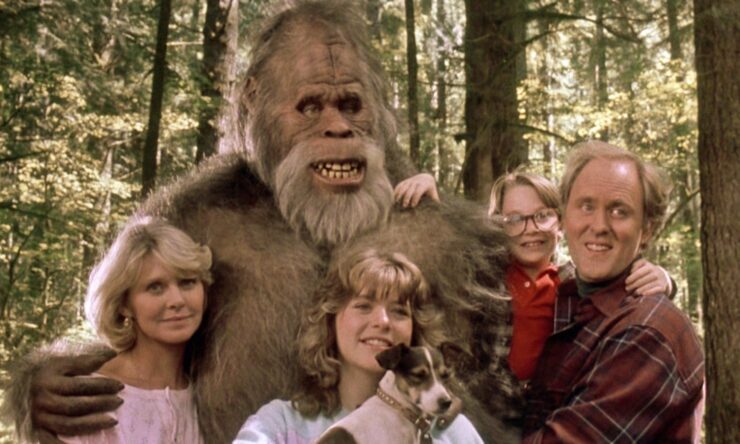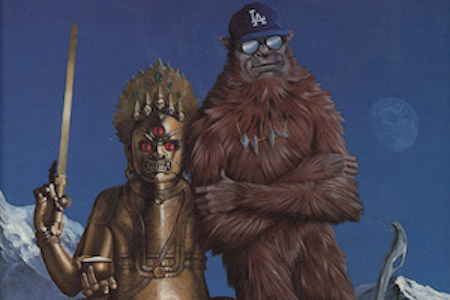I wanted to begin this chapter with an enduring classic, The Abominable Snowman. It has Peter Cushing! And Forrest Tucker! Alas, I could find no captioned version available to stream, and the DVD (which purports to be captioned) is a little bit spendy. I had to go with Plan B, which involved some spelunking through the canon of great big hairy cryptoprimates on film.
The winner of this week’s toss is twenty years younger and rather lower in star power, though it features a major name in its time, Yvette Mimieux (who is best known for her role in 1960’s The Time Machine). She plays the lead, intrepid television reporter Ellen Seberg, and lesser light Bo Svenson stars as her husband, Gar. Mimieux, who was usually cast as a blonde beauty, is a lightly frosted brunette here. She’s the future of journalism, we’re told: television is where it’s happening. For further adulting points, she’s married to an Olympic skier, but the marriage has gone stale and so has Gar, who hasn’t stepped on skis since he won his gold medal.
Ellen and Gar arrive at the ski resort in Colorado where they both got their start, just before the fiftieth annual Winter Carnival. The monster action has already begun. A pair of ski bunnies, Jennifer and Heidi, skimming down a long, deserted slope, disagree as to how much longer they should stay out. Pretty blonde Jennifer wants to keep going. Plain brunette Heidi has a bad feeling and wants to go back to the lodge.
Suddenly they see a trail of enormous tracks heading toward the trees. Somebody’s playing a practical joke with a set of novelty snowshoes, Jennifer declares. They hear a not so distant roaring. Heidi gets the hell out of there. Jennifer lingers, peering into the woods.
We all know what has to happen next. The look of bland skepticism shifting to horror. The—whatever it is—racing toward her. The camera cutting away to Heidi, now out of sight. The scream.
Cut to the crowded resort and the getting-ready-for-Winter Carnival montage. Mrs. Rill, the grande dame of the resort, oversees the festivities. Stalwart grandson Tony gets called out by the ski patrol in the person of equally stalwart Buster, to the cabin where Heidi is waiting. Heidi is hysterical, but she sticks to her story: Jennifer has been abducted by a monster.
The plot unfolds in classic monster-movie fashion. Tony and the ski patrol search in vain for Jennifer. Tony finds her torn and blood-stained jacket, but no sign of the rest of her. When she does turn up, after assorted subplots and distractions, she’s very dead.
The Gar and Ellen subplot revolves around Gar’s urgent need for a job, Ellen’s deep discontent with him and her marriage, and the reason why Gar stopped skiing so abruptly. It’s surprisingly timely. Gar underwent a process similar to the one that caused gymnastics superstar Simone Biles to withdraw from competition during and after the 2020 Olympics. Gar made it through the event to the medal, but he hasn’t skied since, let alone competed. Part of his journey as a character will require him to get back on skis and perform appropriate Plot Heroics. And, of course, win back his bride.
The resort has its own troubles. It needs the Winter Carnival to be a success, and it cannot afford a mass panic over a murderous monster. Mrs. Rill insists on suppressing Heidi’s story and ascribing Jennifer’s death to a rogue grizzly. The Sheriff even manages to produce one, suitably deceased, to allay any fears among the Carnival-going public.
But Heidi isn’t the only person who believes in the monster. Tony has actually seen it, at a distance and hidden in trees, but he makes out enough to know it’s neither a human nor a bear, but something Other. He thinks he knows what it is. It’s Bigfoot.
It just so happens that Ellen has done a television special on that very creature. Gar knows all about it, and is happy to educate Tony. The heart of Bigfoot’s range may be the Pacific Northwest, but Ellen has interviewed people all over the country. There may be hundreds of the cryptids roaming the wilderness of North America.
They’re not dangerous, Gar maintains. They don’t have a history of attacking humans. He’s not in favor of hunting down and killing it.
Jennifer’s mutilated body turns up in an isolated barn, and Buster the ski patroller meets the monster on the trail and ends up dead. Gar pivots to Tony and the Sheriff’s view. Like any other animal that attacks humans, it has to be destroyed.
And then it attacks the Carnival, leaving a trail of blood and mayhem. There’s only one thing to do, and Gar nerves himself up to do it. He puts on skis. He heads out on the hunt.
Gar is on a hero’s journey. The monster is monstering because monster. Maybe it’s a mutant, is the best expertise Ellen can offer. (Yep. A man has to ‘splain—er, relay her knowledge to another man.) Once it’s taken first blood with Jennifer and Buster, it heads for the light and noise of the Carnival, terrorizes the Snow Queen by peering in the window of the lodge at her, and shreds the driver of the SUV that’s rather cutesily labeled “Snow Queen’s Carriage.” It seems to decide it’s had enough by that point and takes off into the woods.
The film gives us monstercam views as it hunts, attacks, and ultimately is attacked. We watch, in blurry, shaky bits of footage, as it locks on its prey. We don’t know why it’s doing it, but we get a good idea as to how.
I have to hand it to the makers of the film. Their special effects budget must have been close to zero. The whole thing is done in quick cuts and fragments. A set of oversized footprints. A massive, shaggy forearm with enormous claws. A monster mask with terrifying fangs. A hairy shadow looming with outstretched arms. Intermittent roaring, sometimes at a distance, sometimes horribly close.
The monster’s victims are equally fragmentary: a bloodstained jacket, a woman’s arm with even more bloodstains, a bloody trail in the snow. It’s on the living characters to reflect what they see. We have to extrapolate from their expressions and body language.
Great acting it is not, but it’s surprisingly effective. It asks the audience to put together the fragments and develop their own conception of the whole. We’re out of the habit of that—Blair Witch and Cloverland notwithstanding.
I kind of like it. I’m not a fan of explicit gore anyway, and I’ve seen enough Bigfoot footage to have a fair sense of what the cryptid is supposed to look like.
This one isn’t the usual dark-pelted Sasquatch. It’s more Yeti-like with its silver-grey coat. In my head canon, maybe it actually is a Yeti, captured in the Himalayas and brought to North America by a rogue researcher. Somehow it escaped, and it’s out for revenge on the humans who imprisoned it.
It doesn’t much matter to the humans in the film where it comes from or why it’s doing what it does. This is a monster movie. Monster stalk, monster kill, monster get killed. That’s how it has to play out, by the rules of its game.














